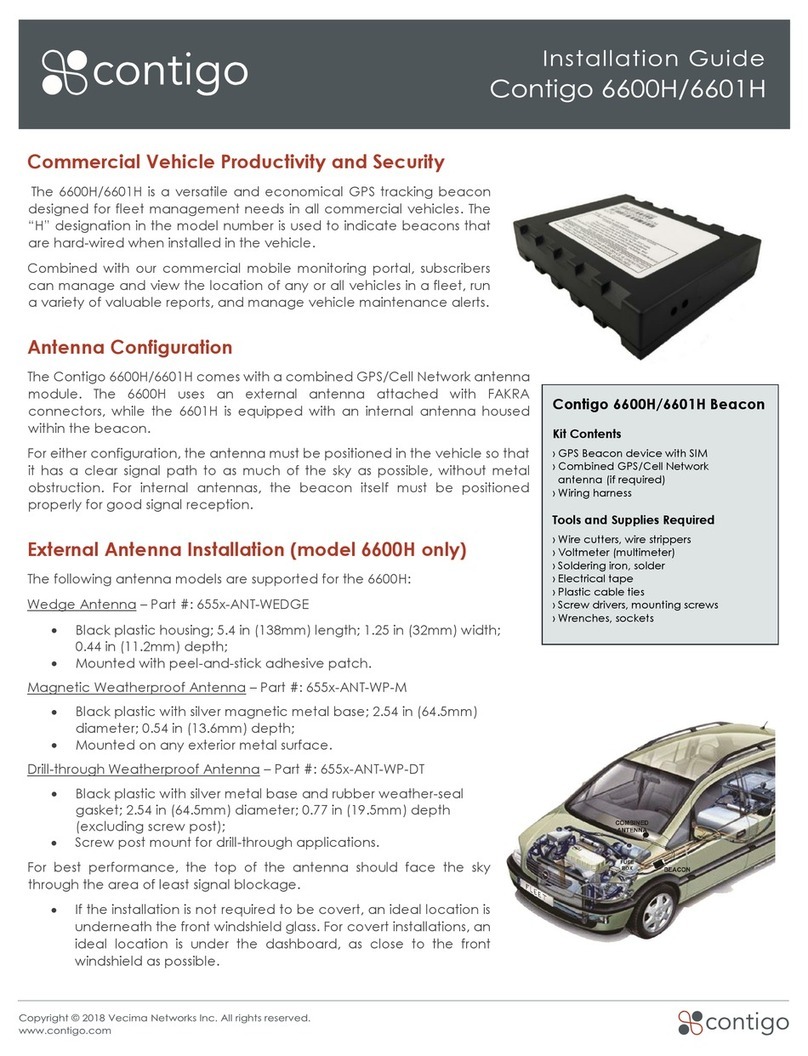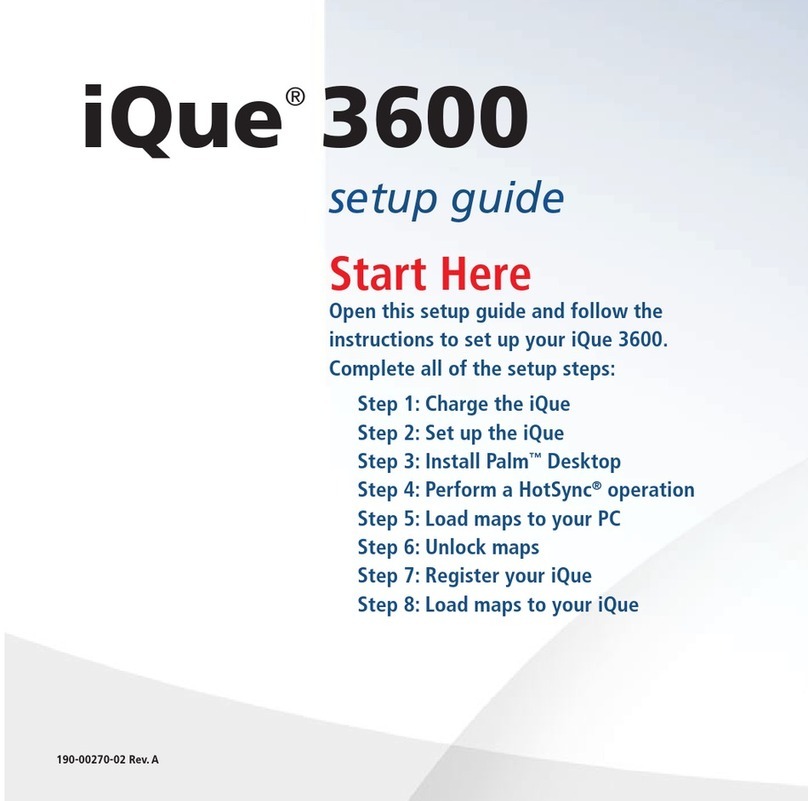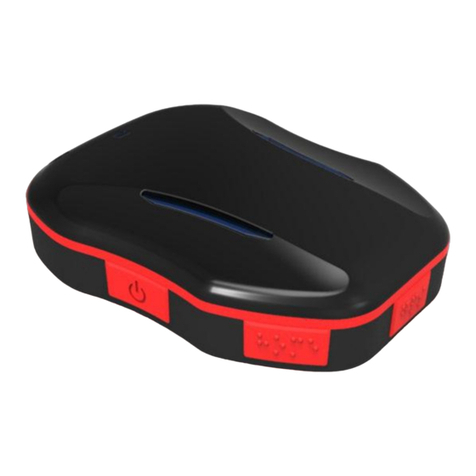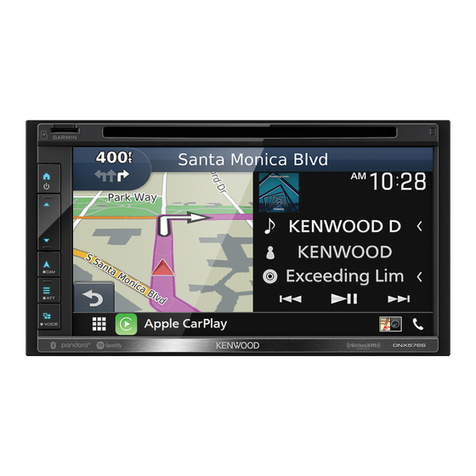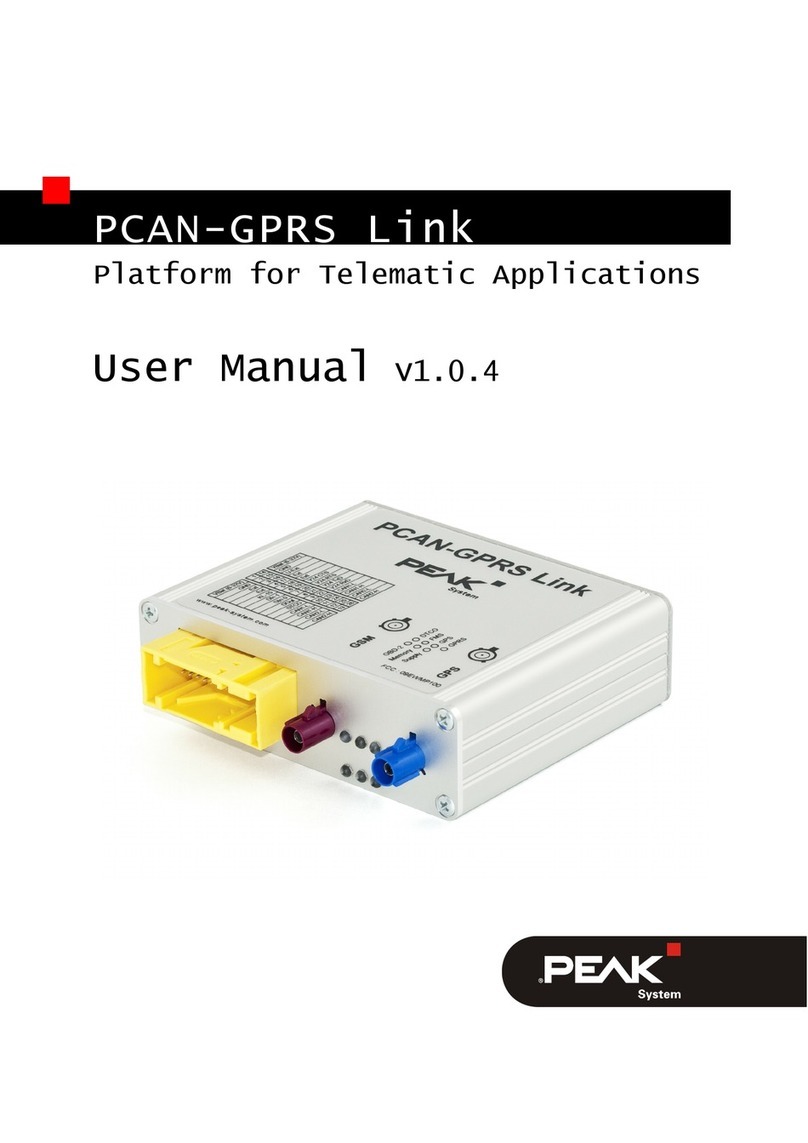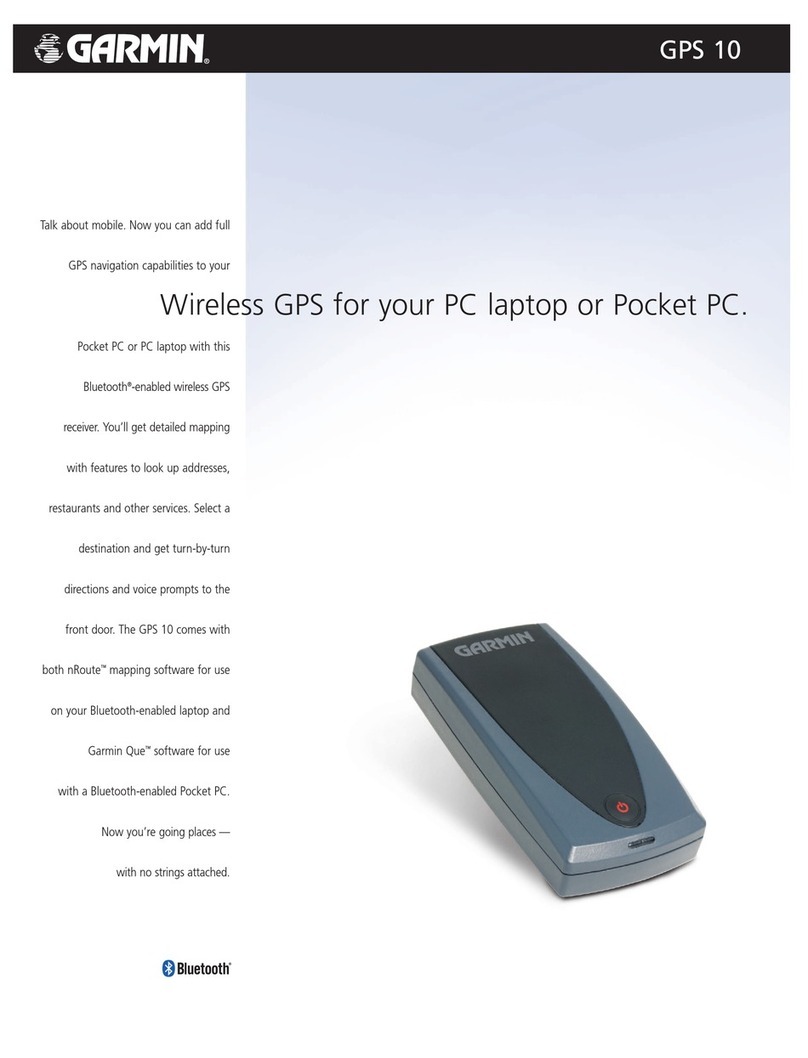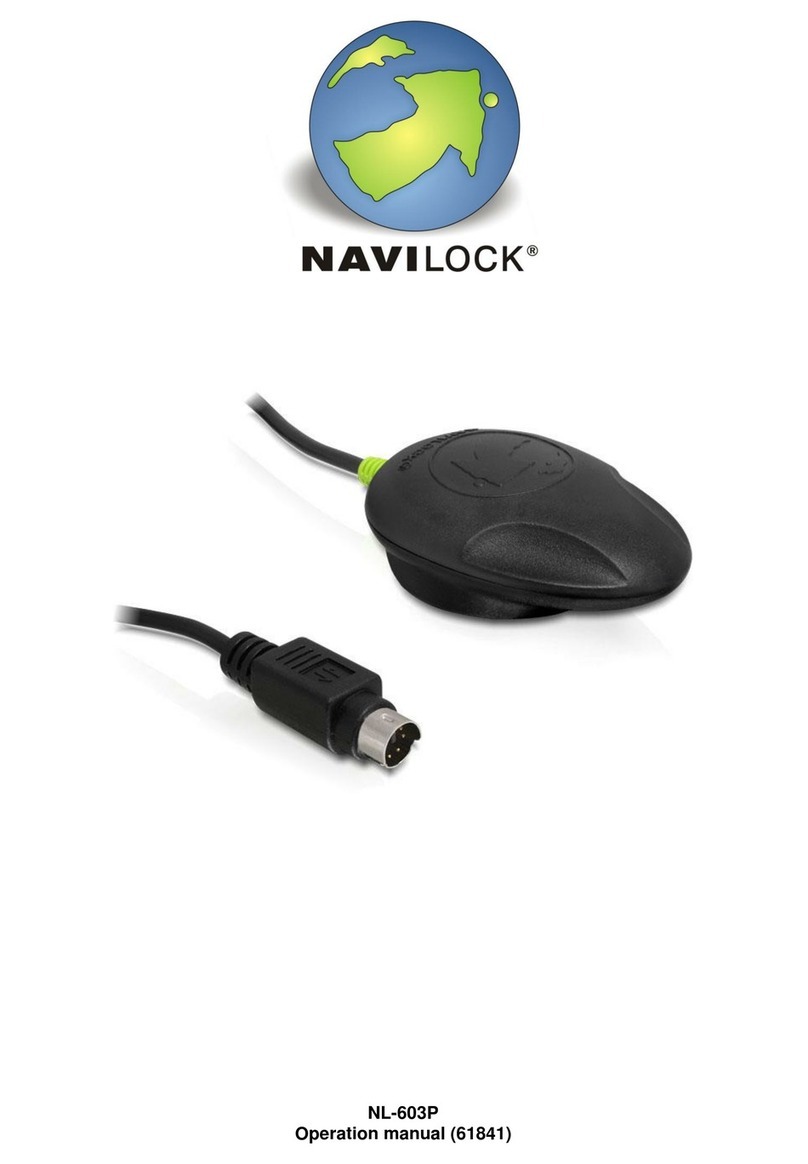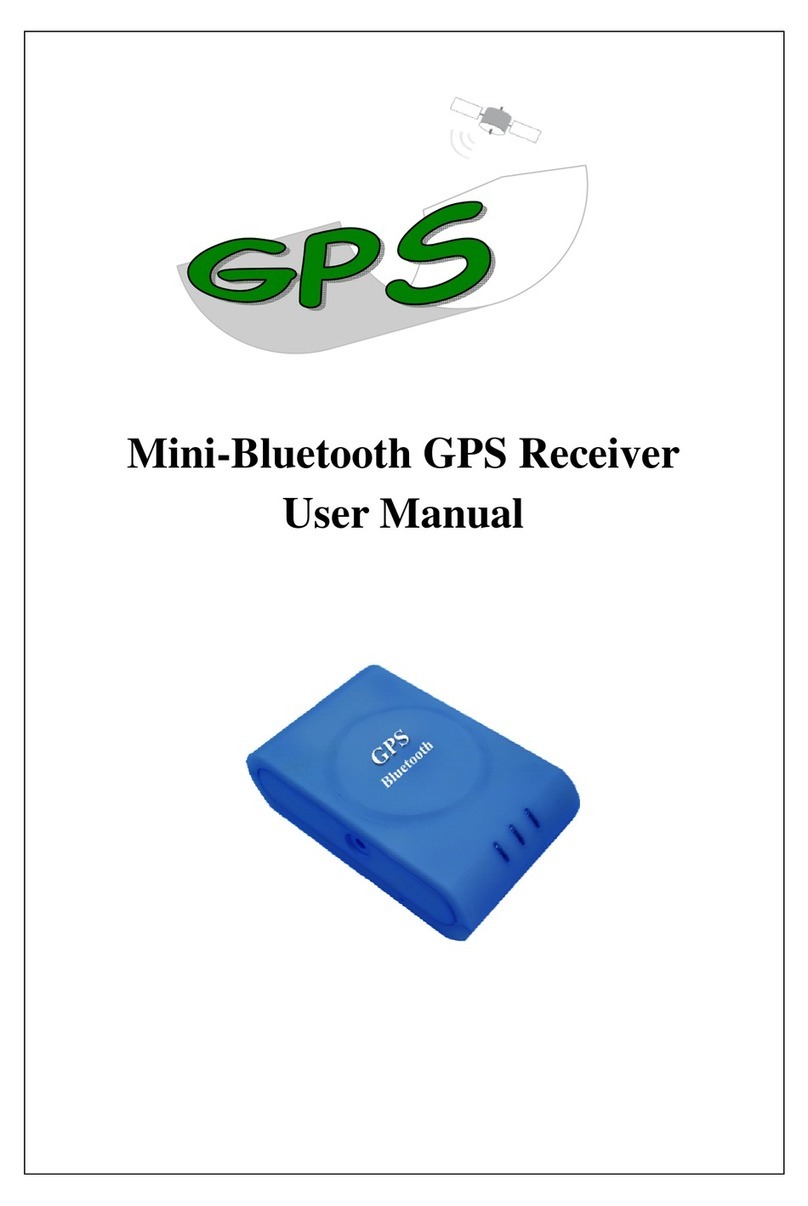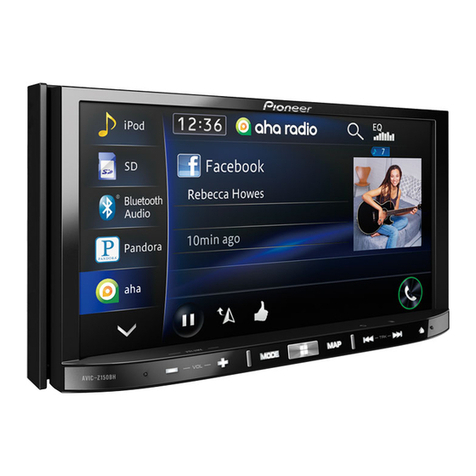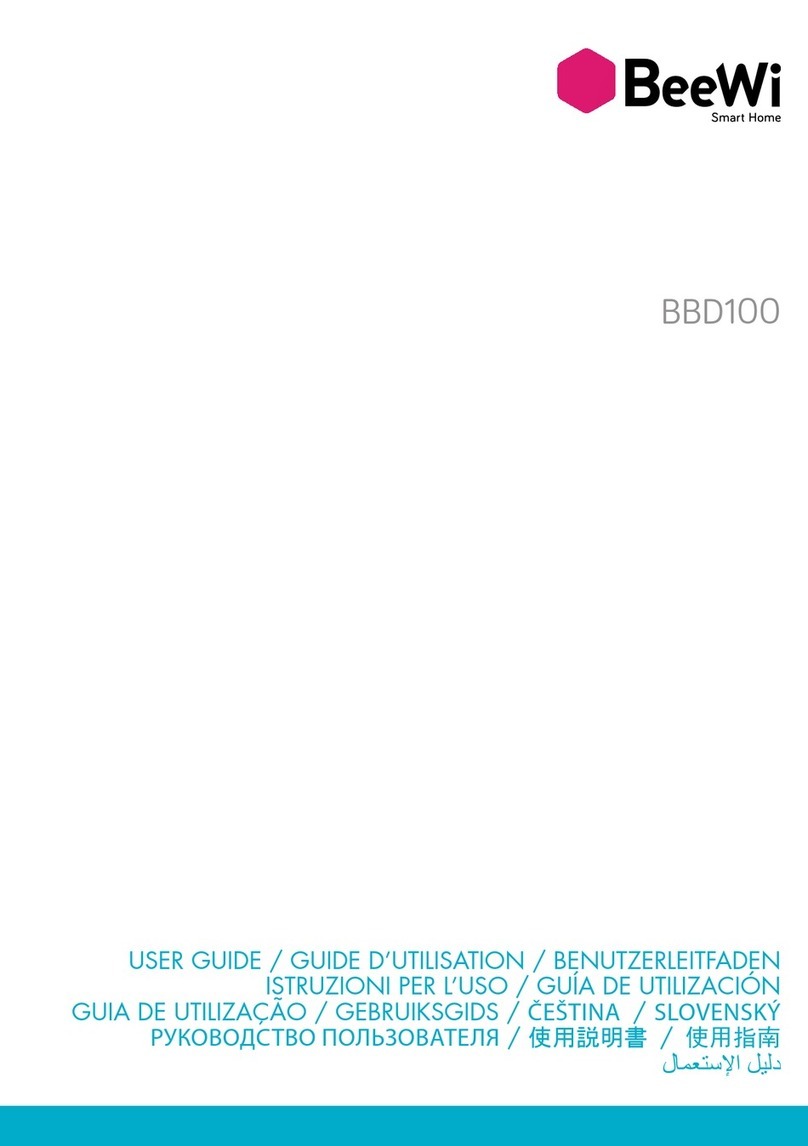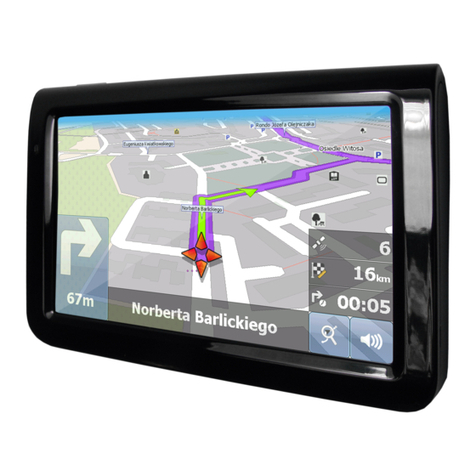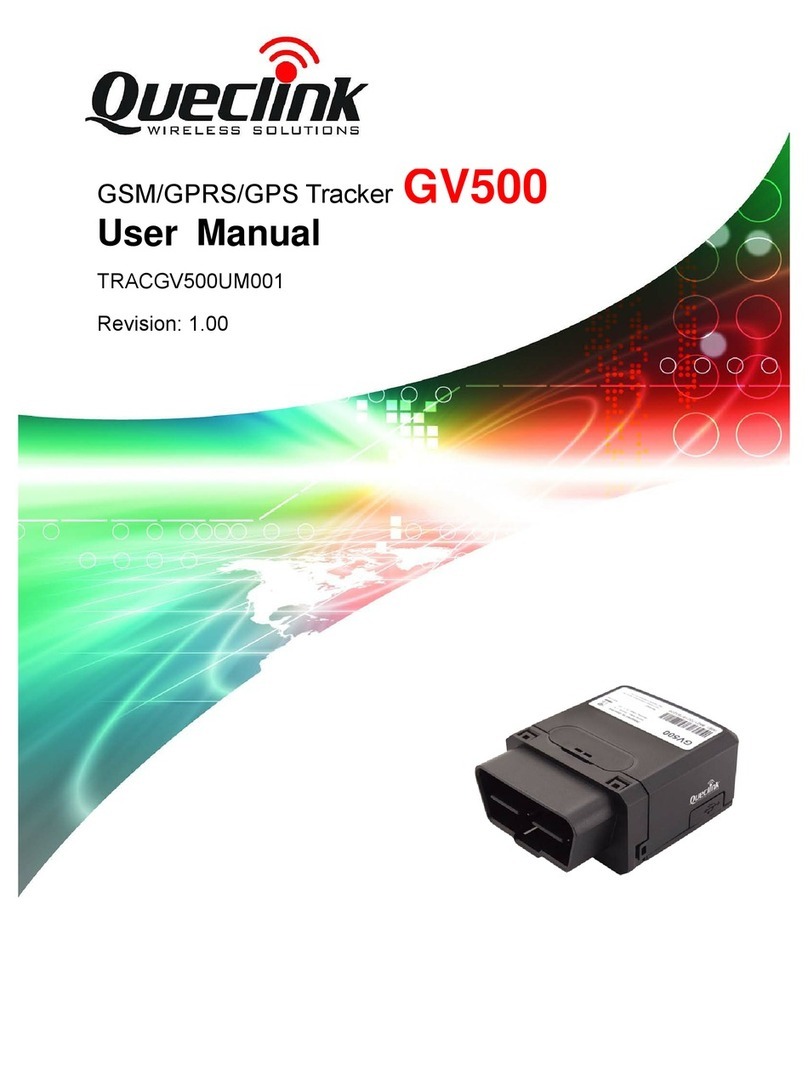BOX Telematics BOX tracker User manual

Communication Protocol v1.5

BOX
tracker
Communication Protocol v1.5 1 of 36
BOX telematics limited
4 Roman Park
Roman Way
Coleshill
West Midlands
B46 1HG
T: +44 (0)1675 434200
F: +44 (0)1675 434300
Legal and notice information.
© Copyright 2001–2009 BOX telematics ltd.
BOX telematics makes no warranty of any kind with regard to this material, including, but not limited to, the implied warranties of
merchantability and fitness for a particular purpose. BOX telematics shall not be liable for errors contained herein or for incidental
or consequential damages in connection with the furnishing, performance, or use of this material.
This document contains proprietary information, which is protected by copyright. No part of this document may be photocopied,
reproduced, or translated into another language without the prior written consent of BOX telematics limited. The information is
provided “as is” without warranty of any kind and is subject to change without notice. Nothing herein should be construed as
constituting an additional warranty. BOX telematics shall not be liable for technical or editorial errors or omissions contained
herein.

BOX
tracker
Communication Protocol v1.5 2 of 36
Preface
This document describes the server communication and configuration protocols used by BOX-tracker. It
provides technical information to allow developers to integrate its functionality into a server application
for vehicle tracking or asset management.
The protocol is based on a TCP connection over the Internet via GSM GPRS and supports both connect
and drop or a permanent server connection. The protocol is based on 7bit ASCII comma separated
values, making it easy to develop and provides features for sending logged data, configuration settings
and firmware updates.
Warning:
This document supersedes all previous provisional release documents prior to 1 February 2009.
Provisional commands and features not detailed in this documentation are no not currently supported
and may stop working in future releases of firmware.
Technical Support
For help and assistance please email TechnicalSupport@box-tracker.com.
Document Conventions
Data sent from the tracker to the server is shown in red and data sent from the server to the tracker is
shown in blue. An symbol also indicates data being sent from the server and indicates data being
sent to the tracker, these symbols do not form part of the data being sent, they are documentation
markers to help clarify the direction of communication. Optional parameters or fields that may be left
blank are shown enclosed in square brackets.

BOX
tracker
Communication Protocol v1.5 3 of 36
Contents
1Document History...................................................................................................................................... 5
2Communication Methods ........................................................................................................................... 6
2.1 GPRS (TCP) Connection ...................................................................................................................... 6
2.2 Commands ....................................................................................................................................... 7
3Commands sent by BOX-tracker.................................................................................................................. 8
3.1 Header Command (H) .................................................................................................................... 8
Log Command (L)................................................................................................................................. 10
3.1.1 Data Items......................................................................................................................... 11
4Firmware Update Protocol ....................................................................................................................... 15
4.1 Firmware Available.......................................................................................................................... 15
FA ....................................................................................................................................... 15
4.2 No Firmware Available..................................................................................................................... 15
N . ...................................................................................................................................... 15
4.3 Firmware Transfer........................................................................................................................... 15
F[,FirmwareVersion,StartPosition] ......................................................................................... 15
F,FirmwareVersion,StartPosition,Length ................................................................................ 15
5Configuration Update Protocol ................................................................................................................. 16
6Configuration Commands......................................................................................................................... 17
6.1 ACCESS.................................................................................................................................. 17
6.2 ADDKEY.................................................................................................................................. 17
6.3 ANC......................................................................................................................................... 18
6.4 ANL.......................................................................................................................................... 18
6.5 CONFIG................................................................................................................................... 18
6.6 DEFAULT ................................................................................................................................ 19
6.7 DELKEY .................................................................................................................................. 19
6.8 DIR .......................................................................................................................................... 19
6.9 FWS_TIME .............................................................................................................................. 19
6.10 GEOF# .................................................................................................................................... 20
6.11 GPRS_APN ............................................................................................................................. 20
6.12 GPRS_USERNAME ................................................................................................................ 20
6.13 GPRS_PASSWORD................................................................................................................ 20
6.14 GPSHC.................................................................................................................................... 21
6.15 GPSD ...................................................................................................................................... 21
6.16 GPSLI...................................................................................................................................... 21
6.17 GPSLI_BOFF........................................................................................................................... 21
6.18 GPSLI_IOFF............................................................................................................................ 22
6.19 IMMOBILISER ......................................................................................................................... 22

BOX
tracker
Communication Protocol v1.5 4 of 36
6.20 IMMOB .................................................................................................................................... 22
6.21 IN............................................................................................................................................. 23
6.22 IDLEALMT ............................................................................................................................... 23
6.23 IGN_OFF_CHG ....................................................................................................................... 23
6.24 JDISTALM ............................................................................................................................... 23
6.25 JTIMEALM............................................................................................................................... 24
6.26 LOG......................................................................................................................................... 24
6.27 ODOMETER............................................................................................................................ 24
6.28 ODOMETER_TRIP.................................................................................................................. 25
6.29 OFFSW.................................................................................................................................... 25
6.30 OUT#....................................................................................................................................... 25
6.31 PANIC_BTN............................................................................................................................. 25
6.32 PASSWORD............................................................................................................................ 26
6.33 PERM_CON ............................................................................................................................ 26
6.34 RESET..................................................................................................................................... 26
6.35 SAVE....................................................................................................................................... 26
6.36 SERVER1_ADDR.................................................................................................................... 27
6.37 SERVER1_PASS .................................................................................................................... 27
6.38 SERVER1_PORT.................................................................................................................... 27
6.39 SERVER2_ADDR.................................................................................................................... 27
6.40 SERVER2_PASS .................................................................................................................... 28
6.41 SERVER2_PORT.................................................................................................................... 28
6.42 SIM_SN_ALWAYS .................................................................................................................. 28
6.43 SPEEDALM ............................................................................................................................. 28
6.44 SYNC....................................................................................................................................... 29
6.45 TIME ........................................................................................................................................ 29
6.46 UPLOADI................................................................................................................................. 29
6.47 UPLOADI_BOFF ..................................................................................................................... 29
6.48 UPLOADI_IOFF....................................................................................................................... 29
6.49 UPLOADD ............................................................................................................................... 30
6.50 UPLOADHC............................................................................................................................. 30
6.51 VALIDATE_KEY ...................................................................................................................... 30
6.52 VBAT12 ................................................................................................................................... 30
6.53 VER ......................................................................................................................................... 31
7Appendix ................................................................................................................................................ 32
7.1 CRC Check Sum Algorithm.......................................................................................................... 32
7.2 Example Communication Sessions .............................................................................................. 33
7.2.1 Disconnected Session Sequence...................................................................................... 33
7.2.2 Permanent connection ...................................................................................................... 33
7.2.3 Firmware Download .......................................................................................................... 34
7.2.4 New configuration.............................................................................................................. 34
7.2.5 Configuration update......................................................................................................... 35
7.3 Road Map....................................................................................................................................... 36

BOX
tracker
Communication Protocol v1.5 5 of 36
1Document History
Ver
Date
Section
Description
1.00
1/11/2008
Preliminary release
1.01
2/2/2009
Various update prior to formal release
1.03
16/4/2009
3.2.1
Event codes 35 & 36 added
5.3
Battery logging details added
5.6
FWS_TIME now defaults to 3600seconds
5.26
PERM_CON (permanent connection) added
5.32
SERVER2_ADDR added
5.33
SERVER2_PASS added
5.34
SERVER2_PORT added
5.35
SIM_SN_ALWAYS added
5.42
VBAT12 added
6.3
Road map updated
1.5
19/6/09
6.15
GPSD added
6.49
UPLOADD added
6.50
UPLOADHC added
3.2.1
Event code 24 modified and event code 25,39,40,41 added.
6.10
GEOFx added
6.19
IMMOBILISER added
6.51
VALIDATE_KEY added
6.2
ADDKEY added
6.7
DELKEY added
6.20
IMMOB added
7.3
Road map updated
5
Configuration Update Protocol
7.2.4
Added New configuration example session

BOX
tracker
Communication Protocol v1.5 6 of 36
2Communication Methods
Commands can be sent to and from BOX-tracker via several methods depending on setup:
Remote connection over GPRS (TCP)
Local RS232 connection
Local USB connection
Remote connection over GSM (CSD)
To configure via its serial port requires a VT100 terminal emulation program such as HyperTerminal,
configured to 115200 baud, 8 data bits, no parity, 1 Stop bit, no flow control.
Commands sent by SMS text message to the tracker must take the following format:
>password,command1,value;command2,value;command3,value……..
Where password is the password of the tracker –see password command.
2.1 GPRS (TCP) Connection
TCP over GPRS is the main communication method and all connections are initiated by BOX-tracker
connecting to the server using a TCP socket. Connections initiated from the server to BOX-tracker are
not supported. If required an SMS command can be sent to BOX-tracker to request it to initiate a
connection with the server otherwise it will connect based on configurable settings.
Once a TCP connection has been made BOX-tracker will pass all logged information without the server
having to make a request. In this situation the communication between BOX-tracker and the server can
be minimal making it easy and quick to develop a communication interface. During a connection the
server may also send commands to BOX-tracker thus providing two way communications. If a
connection is interrupted BOX-tracker will initiate a new connection and resume communication
without loss of data as long as these protocols are followed.
When a connection is first opened a header command is sent to the server. This command identifies the
tracker and provides the server the ability to verify if the connection is valid for security reasons. The
header does not need any response from the server and can be ignored if preferred.
Following the header the tracker will send log commands containing the data logged since the last
connection and which have not been sent to the server successfully.
After sending the logged commands BOX-tracker will send an END (E) command to notify the server all
data has been passed. The server should respond with an ACK (A) command so the tracker knows the
data has been received, thus preventing it from being sent again.
BOX-tracker will process any command the server has sent prior to the above ACK command. If no
commands have been sent or once they have been processed the tracker will drop the connection,
unless configured to keep it open. If the connection is configured to remain open then logged data will
be sent in real-time at intervals based on configurable settings.

BOX
tracker
Communication Protocol v1.5 7 of 36
The following shows a typical communication session:
H,BT,358281002435893,081028142432,F5813D19,6D6E6DC2
L,081028142429,G,52.51084,-1.70849,0,170,0,1,0
L,081028142432,G,52.51081,-1.70849,0,203,0,16,0
E,1
A,1
2.2 Commands
All communication is 7bit ASCII based.
A command consists of an initial word, often abbreviated to a single character, followed by one or more
optional parameters. Neither the command name nor the parameters are case sensitive, unless
otherwise documented. Any leading or trailing spaces within the command name or each parameter are
ignored. Each command sent must be terminated by a Carriage Return (0xD) or within an SMS by a
percentage (%) symbol. The only exception is a command sent via SMS where the last command need
not be terminated.
A command may contain mandatory or optional parameters. Parameters are separated by a comma and
if a parameter is not required it can be omitted. If a single parameter contains a space, comma or
semicolon then it must be enclosed in double quotation marks (0x34). Quotation marks may not be
contained within a string parameter.
Note: Legacy commands or features not documented here should not be used as they may stop
working in future versions of BOX-tracker.

BOX
tracker
Communication Protocol v1.5 8 of 36
3Commands sent by BOX-tracker
The following are the primary commands used during a GPRS connection to pass logged information
from the tracker to the server.
3.1 Header Command (H)
H, DeviceType,SerialNum,DateTime,SecurityToken,FirmwareVer[,SimNumber]
When a TCP connection is first made BOX-tracker will send the header command. The header command
is never sent via SMS, instead a simple password is included.
If the header command is not received within 15 seconds of a connection first being made, or instead
any other command is received, it is suggested that the server drop the connection as an unknown
source may be attempting to connect to the server.
The header command consists of the single H character followed by several parameters.
H,DeviceType,SerialNum,DateTime,SecurityToken,FirmwareVer[,SimNumber]
eg
H,BT,N878123,080415081234,D63E6DD9,6D6E6DC2,8944100300825505377
Device Type = BT
Serial Number = N78123
Date & Time = 2008-04-15 08:12:34
Security Token = D63E6DD9
Firmware = 6D6E6DC2
SIM number = 8944100300825505377
Device Type The device Type defines the type of device the server is communicating with. Currently
BOX-tracker only returns the string BT. In the future other Device Type strings may be
returned to identify different version or types of device, allowing the server to handle
communication differently according to protocols required.
The device type identifier also allows this protocol to be used by other tracking
suppliers who choose to implement it. They would provide a different Device Type and
this would identify their tracker from BOX-tracker.
For most cases this identifier can be ignored.
Serial Number The serial number is the number which uniquely identifies each BOX-tracker. The serial
number can be found on the BOX-tracker case.

BOX
tracker
Communication Protocol v1.5 9 of 36
Date Time The current date and time of the trackers real-time clock. Whilst BOX-tracker normally
synchronises its time from the GPS receiver this value can be used by the server to
verify the time is correct and send a command to correct it. However Its main purpose
is to provide a constantly changing security token.
The date and time is formatted as YYMMDDHHmmss.
e.g. 090201033229 wound be 1st February 2009 3:32:29am
Security Token The Security Token allows the server to validate and authenticate an incoming
connection. The number contained in the security token is based on defined rules such
that it changes each time but can be verified as being valid. If so desired the server can
ignore this number but by ensuring the security token is valid (i.e. adheres to the
algorithm detailed below) there is a higher probability the connection is from a known
source.
The Security Token is based on a standard CRC32 (Cyclic Redundancy Checksum)
algorithm (see appendix for an example) and passed as 8 hexadecimal digits.
The Security Token is calculated by concatenating the Serial Number, Date Time string
(as passed in the header command), and a secret password (which can be configured)
into a single string and using this to obtaining a CRC32 value. Commas are not included
in this string. The default secret password is “password”, without the quotation marks.
This password can be changed. The CRC calculation is based on a case sensitive string.
For a header of
H,BT,358281000146500,080401153209,9F84265E
The security token is calculated on the string
35828100014650008041153209password
Where
358281000146500 = is the Serial Number
080401153209 = is the DateTime (2008-04-01 15:32:09)
password = your hidden password which has a default of
“password”
9F84265E = 8 digit security token
The security token is passed as an 8 digit Hexadecimal formatted number.
Firmware This field contains the current firmware CRC as 8 hexadecimal digits. See firmware
update for further details.
SIM Number The SIM number of the card currently inserted is returned in the header command.
However as this number changes infrequently it is not passed in every header
command, instead it is included once every 48 hours or the first time after the SIM has
been changed. This helps reduce communication overheads. If present the server may
use this to update local records.

BOX
tracker
Communication Protocol v1.5 10 of 36
If required the SIM number can be configured (via the SIM_SN_ALWAYS command)
to always be present. This allows the SIM number to be used to identify the tracker
instead of the serial number.
Log Command (L)
L, <DataTime>,<DataItem>,<Values>[;<DataItem>,<Values>][;<DataItem>,<Values>]
The Log command is used to pass historical (or real-time) log entries recorded by BOX-tracker. The log
command consists of a single Lcharacter followed by the date and time, Data Item and its optional
parameters.
A single log command can contain multiple Data Items where each is separated by a semi-colon ( ;)
character (0x3B). A Data Item is only ever included once in a Log Command but each Data Item (listed
below) is not necessarily included in each log command nor can the order of the Data Items be assumed
to be consistent.
It is therefore important to parse the log command by splitting on semi-colons and checking the name of
each Data Item before handling the values associated with the Data Item.
Date Time The date and time is always in the format YYMMDDHHmmss and is the time the log
record was made. If multiple Data Items are included in the log command then all were
recorded at this time.
Data Item BOX-tracker can log a variety of Data Items, the name of which is passed prior to its
values. The Data Item name allows the server to identify how to handle its values. The
following Data Item names are currently used; additional Data Items may be used in the
future. (See later for a detailed description of each)
Name Description
G GPS position with event code, speed, direction and distance
END End of journey information
DID Driver ID as a string
GF Geofence entry or exit
DI0 Digital Input 1 with a value of 0 or 1
DI1 Digital Input 2 with a value of 0 or 1
AI0 Analogue Input 1 with it integer value
AI1 Analogue Input 2 with it integer value
AI2 Analogue Input 3 with it integer value
AI3 Analogue Input 4 with it integer value
BOOT Reboot reason
FAULT Fault reason as a string
Values The values passed after a Data Item name depends on the Data Item. Some may only have
a single value others may have many, each separated by a comma. See the following for
specific details of what is included.

BOX
tracker
Communication Protocol v1.5 11 of 36
3.1.1 Data Items
G, Latitiude, Logitude, Speed, bearing, Distance, EventCode, Status
The main Data Item is G, which is used to pass all GPS location data. Seven values are passed after the G
Data Item name each separated by a comma:
Latitude Latitude is a signed floating point number representing degrees and fractions of a degree
between -90.0 and +90.0. North is positive, South is negative.
Longitude Longitude is as a signed floating point number representing degrees and fractions of a
degree between -180.0 and +180.0. East is positive, West is negative.
Speed A decimal number specifying the speed the vehicle was travelling (in kph) when the log
was made.
Bearing A decimal number specifying the direction of travel when the log was made. The bearing is
specified in whole degrees (0 to 360).
Distance By default this contains the distance travelled since the start of the journey (travel). This
can be configured to return the odometer reading if required. Distance is returned as a
floating point number in Kilometers.
Event Code The event code defines the reason why the log entry was made. The following event codes
are returned, however, future firmware releases may return additional event codes. The
event code is a decimal number.
Value
Description
1
Interval timer.
The BOX-tracker can be configured to log locations at configurable intervals. This event
indicates the log occurred as a result of the interval timer.
2
GPS heading has changed. This only occurs whilst the ignition is on.
3
Poll Request Via SMS.
A command has been received via SMS requesting the location to be logged and passed
to the server.
4
Tracker pushbutton pressed.
When the BOX-tracker pushbutton is pressed a connection is made to the server.
5
External Panic Button pressed.
The external panic button has been pressed.
6
Ignition on.
7
Ignition off.
18
GSM signal jamming has been detected.

BOX
tracker
Communication Protocol v1.5 12 of 36
19
GPS Tamper.
Occurs when the GPS antenna is removed or a fault occurs.
20
Journey Distance Exceeded.
This event is logged when the distance of the current journey exceeds a configurable
value.
21
Journey Time Exceeded
This event is logged when the length of the current journey exceeds a configurable time.
22
Speeding
The speed of the vehicle has exceeded a configurable value. The speed of the vehicle
must drop by 20% before this event will occur again.
24
Geofence Entered A geofence has been entered
25
Geofence Exited A geofence has been exited
28
External Power On (See the VBAT12 command)
The external power (vehicle battery) has been turned on. Usually in a vehicle this will only
occur once when first installing or when the vehicles battery is reconnected after
servicing.
29
External Power off (See the VBAT12 command)
The external power (vehicle battery) has been removed.
32
Idle Event
Occurs when the tracker remains stationary with the ignition on for more than a
configurable period of time.
34
Internal battery low
35
External battery low (See the VBAT12 command)
36
External battery failed (See the VBAT12 command)
39
Allow start with driver ID key (See the IMMOB command)
40
Prevent start (See the IMMOB command)
41
Allow start without driver id key (See the IMMOB command)

BOX
tracker
Communication Protocol v1.5 13 of 36
Status This defines the status of the vehicle at the time the log was made. The value is passed as
a hexadecimal number each bit within this number has a specific meaning as described
below.
Bit
Value = 0
Value = 1
0
Ignition is off
Ignition is on.
1
Vehicle is stationary
Vehicle is moving.
2
True position
Last known position#1
#1 When a GPS fix is unavailable the last know position is returned, Bit 2 indicates if this
has occurred.
eg. L,080328112435,G,52.4,-1.3,101,94,23.89,1,1
Time stamp = 2008-03-23 11:24:35
Latitude = 52.4 degrees north (north is positive and south is negative)
Longitude = 1.3 degrees west (east is positive and west is negative)
Speed = 101 kph
Bearing = 94 degrees (0 degrees = north)
Distance = 23.89 kilometers since ignition on (may be blank in certain applications)
Event Code = 1
Status = 1 (ignition on)
End, MaxSpeed, IdleTime, StartTime
Returns information relating to the last journey. This Data Item is passed when an ignition off occurs.
MaxSpeed Maximum speed which occurred during the journey, specified as a decimal number in Kph
IdleTime Total number of seconds the vehicle was idle during the journey. (Decimal number)
StartTime The time the journey started in the format YYMMDDHHmmss
eg. L,080328112435,END,68,450,080328104720
DID, value
Returns the driver ID number (as a string) of the driver key presented by the driver.
eg. L,080328112435,DID,0xC9A3ED000000 Driver key C9A3ED000000.

BOX
tracker
Communication Protocol v1.5 14 of 36
GF#, value
Returns a value which indicates if a Geofence was entered or exited
#Defines the geofence number affected. A decimal number (1 to 64)
Value 1 = Entry, 0 = Exit
eg.
L,090617113820,G,52.51045,-1.70872,2,22,0.13,24,3;GF2,1 Geofence 2 entered.
L,090617123820,G,52.54045,-1.72872,2,22,0.13,25,3;GF2,0 Geofence 2 exited
DI#, value
Defines the status of a specific digital input.
DI# The Data Item name where # defines the digital input number (0 or 1)
Value Either the value 0 or 1, indicating the state of the input
AI#, value
Defines the status of a specific Analogue input.
AI# The Data Item name where # defines the analogue input number (0 to 3)
Value Floating point number representing the measured Voltage
BOOT, message
Message is a string and explains the reason why BOX-tracker has been rebooted.
FAULT, message
Message is a string which describes a fault that has occurred on BOX-tracker.

BOX
tracker
Communication Protocol v1.5 15 of 36
4Firmware Update Protocol
Firmware updates are controlled by the server notifying BOX-tracker that a new version is available.
BOX-tracker then requests the server to send the firmware. The firmware is sent as a stream of bytes
over the same TCP connection. Should the connection drop during this process then on reconnecting
BOX-tracker will request the server for the remaining bytes not received. This method allows for reliable
updates, even when GSM coverage is unreliable, without requesting the same data multiple times.
At no time should the server start sending the firmware without having received a request from
BOX-tracker to do so.
If preferred, firmware updates may be collected from the servers hosted at BOX telematics by setting
the FWS_TIME parameter (See section 6.9).
4.1 Firmware Available
FA .
The server should check the firmware version number passed in the Header (H) command to see if a
later version is available. If a new version is available then the server should send an FA command to the
tracker.
On receipt of the FA command, and after all logs have been sent, BOX-tracker will send an FCommand
(see below) requesting the server to start stream the firmware data.
4.2 No Firmware Available
N .
Whilst there is no reason for this to happen, if BOX-tracker were to request a version of firmware which
does not exists then this command can be sent by the server to terminate the upload request.
4.3 Firmware Transfer
F[,FirmwareVersion,StartPosition]
F,FirmwareVersion,StartPosition,Length
FirmwareVersion The firmware version is obtained from the filename of the firmware file, without the
extension. Currently this is also the CRC32 check sum of the data contained within
the file but this may change in the future.

BOX
tracker
Communication Protocol v1.5 16 of 36
StartPosition The start position requested by BOX-tracker in the F command or zero if a file
different to that being requested is being sent. This is formatted as a decimal
number.
Length The length of the firmware data (from the first byte to the last). This is formatted as a
decimal number.
On receipt of an FA command BOX-tracker will send an F command, without any parameters, to request
the server to start sending the latest firmware. If firmware data is available the server should send an
F Command in response to this request. Immediately following this command the server should start
sending the firmware data as a stream of bytes.
Should the download be interrupted BOX-tracker will resume the download by sending an FCommand
with the firmware version partly received and the last position within the firmware data that it received
successfully. The server should respond by sending an FCommand containing the firmware version,
start position (as requested) and the remaining number of bytes being sent. It should then start sending
the firmware data from the position requested.
If on resuming a download the server has a new firmware version available then instead of resuming the
sending of the requested firmware it may instead send the new firmware from the start. If this happens
the FCommand should be sent with the new firmware version, a start position of zero and the length of
the firmware data. BOX-tracker will see the firmware version is different to that requested and will start
receiving the new firmware form the start.
5Configuration Update Protocol
If on connecting the tracker has no configuration (because it has never been programmed or because it
has been cleared (defaulted)), it will send a CN Command to request all configuration setting. The server
will stream all the commands configured for the unit and at the end the server will send an Ecommand
and await receipt of the A command.
If on connection to the server the server identifies it has new commands to send to the tracker it will
send a CR command and await the tracker to request them. On receipt of CP command the server will
stream just the pending commands (those changed since the last time the tracker requested them). At
the end the server will send an Ecommand and await receipt of the A command.
On receipt of the “A” command the tracker will record the date the commands were last sent so they
are not sent again.

BOX
tracker
Communication Protocol v1.5 17 of 36
6Configuration Commands
The following commands may be sent to the tracker to configure it to behave in different ways or to
requests a specific action.
6.1 ACCESS
This commands allows the password access requirement to be turned on or off for specific
communication methods. A single decimal number follows; each bit within this number relates to a
communication method and defines if a password is required before access is allowed.
If a bit is true (1) a password is required and access won’t be allowed until this is entered. If the bit is
zero then no password is required when first communicating with the tracker, via the specified method.
This command has no affect in controlling communication over GPRS. GPRS communication is initiated
by the tracker and uses a more comprehensive security method.
Bit
Access Method
0
RS232 Command line
1
USB Command line
2
GSM Command Line
3
SMS Command Line
E.g. USB and SMS requires a password
ACCESS,10
Default value: 12 (password required for GSM and SMS access).
Range: Decimal number representing a single 8-bit byte
See also the PASSWORD command (section 6.32)
6.2 ADDKEY
This command is used in conjunction with the immobilisation & Validate keys feature.
Addkey adds a new key number to the driver ID key table held in non-volatile memory. The key
identifier length cannot exceed 18 characters. The key string must contain only alpha numeric
characters i.e. a-z, A-Z and 0-9.
E.g. add key 123456789
addkey,1,123456789
When a driver ID key is presented (by Dallas iButton© or other electronic key reader) the key table is
searched and if the key is found the vehicle is allowed to start via the immobilisation feature.
If the key is not found in the table the buzzer will beep (if enabled and fitted).
See also IMMOBILISER , VALIDATE_KEY, IMMOB, DELKEY

BOX
tracker
Communication Protocol v1.5 18 of 36
6.3 ANC
Enabling or disabling logging of analogue channels 0 to 3 and the externally battery supply. Each
parameter may be set to a 0 (disable logging) or 1 (enable logging)
Parameter 1 = Analogue Channel 0
Parameter 2 = Analogue Channel 1
Parameter 3 = Analogue Channel 2
Parameter 4 = Analogue Channel 3
Parameter 5 = External battery
To enable logging analogue 0 and analogue 1
ANC,1,1,0,0,0
To enable logging the external battery supply
ANC,0,0,0,0,1
Default value: 0 for all parameters
Range: Each parameter can be 0 or 1
6.4 ANL
Defines the rate (in seconds) the enabled analogue channels are logged (See ANC command). If this
value is set to zero then no Analogue channels will be logged even when enabled via the ANC command.
Default value: 0 seconds
Range: 0 to 4,294,967 (47 days)
6.5 CONFIG
Returns the current settings, the order and specific settings returned may vary depending on the
firmware version.
CONFIG
ACCESS 12
ANC 0,0,0,0,0
ANL 0
FWS_TIME 3600
GPRS_APN ""
GPRS_PASSWORD "pass"
GPRS_USERNAME "user"
GPSD 0
GPSHC 0
GPSLI 60
GPSLI_BOFF 86400
GPSLI_IOFF 86400
IDLEALMT 0
IGN_OFF_CHG 0
IMMOBILISER 2
IMMOB 0
JDISTALM 0
JTIMEALM 0
ODOMETER_TRIP 1
OFFSW 1
OUT0 0
OUT1 0
PANIC_BTN 1
PASSWORD "password"
SERVER1_ADDR ""
SERVER1_PASS "password"
SERVER1_PORT 0
SERVER2_ADDR ""
SERVER2_PASS "password"
SERVER2_PORT 0
SIM_SN_ALWAYS 0

BOX
tracker
Communication Protocol v1.5 19 of 36
SPEEDALM 0
UPLOADD 320
UPLOADHC 1
UPLOADI 300
UPLOADI_BOFF 86400
UPLOADI_IOFF 86400
VALIDATE_KEY 1
VBAT12 1
OK
6.6 DEFAULT
The default command sets all settings to its default state (factory default). Most alarms and events are
disabled.
6.7 DELKEY
This command is used remove a driver ID key from the key table that has previously been added using
the addkey command.
E.g. to delete key 123456789ABC from group A enter
delkey,A,123456789ABC
The DELKEY,ALL command will delete all keys (in all groups).
6.8 DIR
Returns a list of all files on the tracker.
6.9 FWS_TIME
If the firmware update protocol (section 4) is not being implemented on your system then firmware
updates can be obtained from the servers at BOX Telematics.
This parameter defines how often the tracker checks these servers for updates. If this is set to 0 then no
checks will be made and any firmware will need to be updated in accordance with the update protocol
in section 4.
Default value: 3600 (Do not check BOX Telematics for updates)
Range: 0 to 2,147,483,646 seconds
Table of contents

